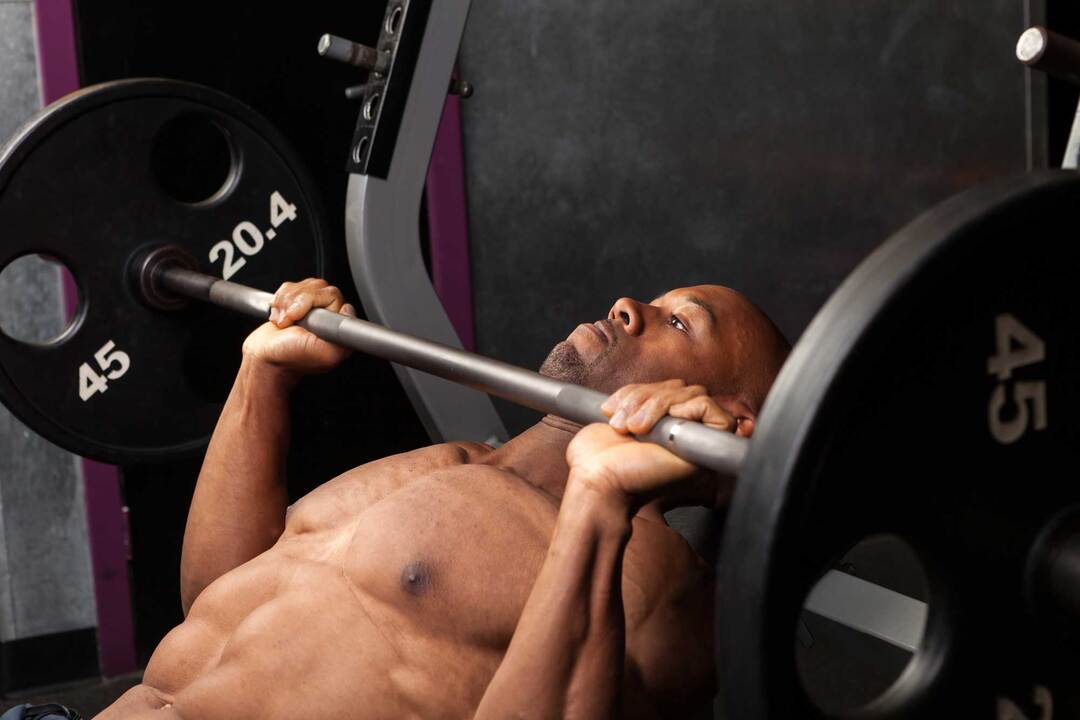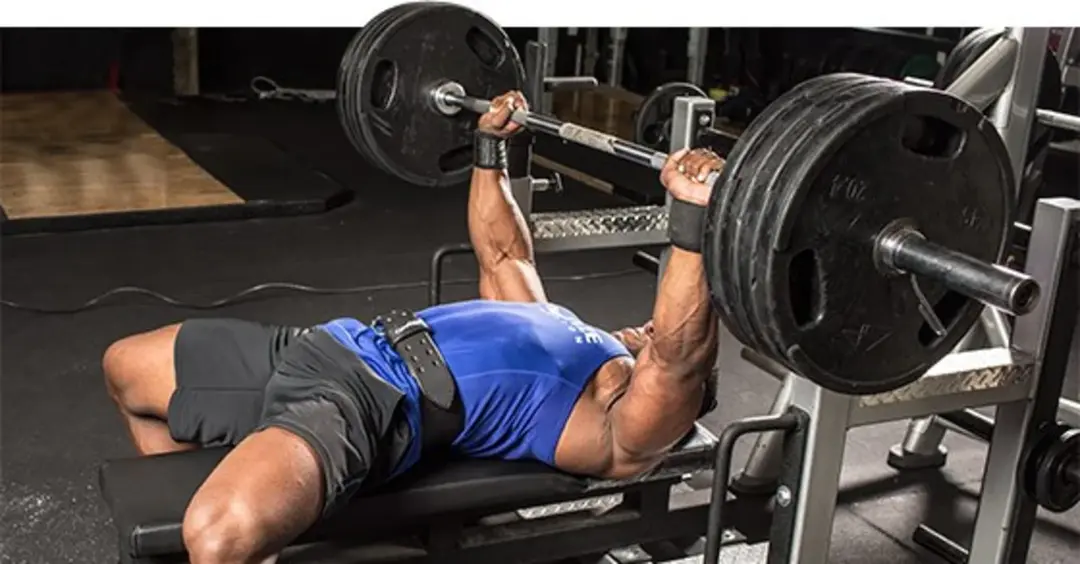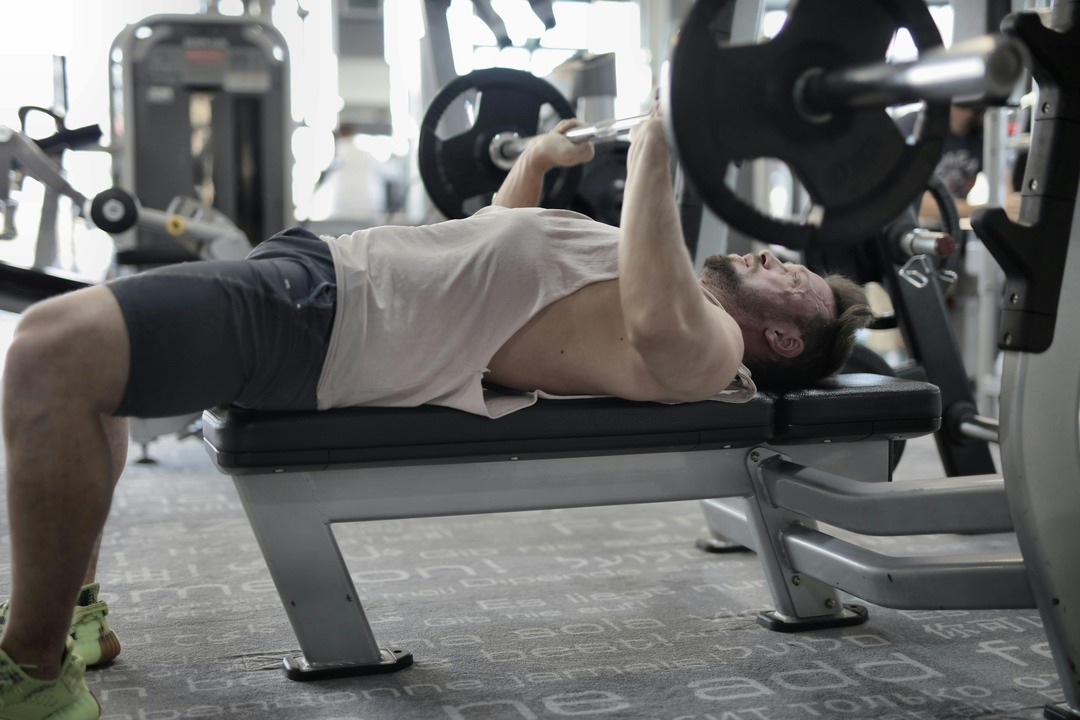What is the Average Male Bench Press?

Find out the average male bench press by age and fitness level, plus how to increase your strength safely and track tangible progress.
You open Best Fitness Apps to track progress and suddenly the bench press numbers blur together: what is average for your bodyweight, and what should a beginner expect versus an intermediate or advanced lifter?
This guide breaks down average male bench press standards, strength benchmarks, and comparisons of one-rep max and rep max by weight class and lifting experience so that you can set clear, realistic goals. Want to know how your 1RM, five rep max, or personal record stacks up in pounds or kilograms?
To put those benchmarks to work, GetFit AI, an AI fitness app, offers simple, personalized plans and progress tracking that align with bench press standards to your bodyweight and experience level.
Summary
- The average male bench press is 135 pounds, and that figure is best treated as a population baseline rather than a personal goal because averages obscure modifiers like bodyweight, technique, and training history; use 135 pounds only to orient programming. This is where GetFit AI fits in: mapping population baselines to personalized targets that account for body weight and experience.
- Training level shifts expectations sharply: an intermediate male lifter averages about 215 pounds, compared with the 135-pound general average, indicating that consistent programming, volume, and frequency drive significant bench press gains over months and years. GetFit AI addresses this by auto-adjusting target loads and workout phases as users progress from novice to intermediate.
- Practical short-term goals and tactics matter; for example, a sensible early milestone is roughly 175 pounds for novices, and reliable progress often comes from microloading with 2.5 to 5-pound increments and training the bench two to three times per week to balance technique and volume. This is where GetFit AI fits in, prescribing microload increments and session roles that maintain technique as incremental gains accumulate.
- Focused high‑intensity blocks can produce rapid improvements, with a controlled trial reporting an average 20-pound bench press increase over 4 weeks and a daily 1RM protocol showing roughly a 10 percent strength increase in 1 month. However, aggressive methods increase recovery and injury risk if not carefully managed. GetFit AI addresses this by sequencing accumulation and intensification blocks and flagging recovery risk when aggressive protocols are applied.
- Objective measurement distinguishes true strength from improved skill; for example, a flexible bar showed eccentric displacement of about 39.84 cm and concentric displacement of 40.17 cm, and unstable loads raised anterior deltoid activation to 97.02 percent versus 76.84 percent in stable conditions, so bar speed, displacement, and activation patterns reveal what is actually improving. This is where GetFit AI fits in: by tracking bar speed and rep consistency metrics to distinguish neural and technical gains from muscular force increases.
- Consistency and centralized tracking scale better than scattered notes, spreadsheets, and guesswork, and real-world adoption signals matter: GetFit AI has over 1 million downloads, and a user survey found that 90 percent of users reported improved fitness after 3 months, suggesting that coordinated tracking and automated adjustments correlate with better outcomes. GetFit AI addresses this by centralizing performance metrics and auto-adjusting loads based on tracked data.
What is the Average Male Bench Press?
.jpeg)
The average male bench press is 135 pounds, and that number is best treated as a population baseline rather than a personal goal. This figure comes from Strength Level in 2023 and helps calibrate where many untrained or casually active men start, not where everyone should stop.
What does that average actually represent?
That 135-pound figure reflects broad, aggregated test results across men with varied body weights and minimal training, so it captures a practical starting line for general upper-body strength. When I use that baseline with athletes and casual gym-goers, it clarifies whether a program should prioritize technique, neural adaptation, or progressive overload.
How should training level change your expectations?
An intermediate male lifter, by contrast, sits in a very different zone; an intermediate male lifter can bench press 215 pounds, according to Strength Level (2023), which shows how experience and consistent programming shift the benchmark upward. In practice, that gap is where programming matters: volume, frequency, rep ranges, and incremental load drive the transition from average to intermediate strength over months and years.
Why do simple averages mislead lifters?
A single number hides three significant modifiers: technique, bodyweight, and training history. Shorter arms and better shoulder positioning can let a lifter press more without being objectively stronger in every way, while someone heavier may move the same bar but lack relative strength. This is why treating averages as context, not destiny, keeps training safe and honest.
When community stories distract from practical advice
Over several months of reviewing user-submitted fitness content, I noticed many narratives stray into fiction or unrelated detail, which teaches a simple lesson: anecdotes often obscure actionable guidance. That pattern explains why beginners pick up myths about form and progression, then stall; the real work is translating clear, measurable practices into consistent weeks of training.
Most people follow one-size-fits-all programs because they are familiar and work at first, but as plateaus and injury risk accumulate, the hidden cost becomes clear: wasted months and lost confidence. Platforms like GetFit AI provide personalized programs, automatic adjustments based on progress, and athlete-mode guidance that turn a static average into a progressive target, helping users move safely from baseline to a strength that fits them.
Which practical next step changes outcomes fastest?
Focus on progressive overload with small, consistent increments and on reliable technique cues, not dramatic jumps. Track proximity to failure—not ego—and use objective checks, such as rep-based progression or weekly volume totals. Those choices compress months of noisy guessing into predictable, measurable gains.
That surface answer is helpful, but what most people miss next will surprise you.
How Much Should I Be Able to Bench Press?

Pick a weight that stresses you enough to improve but not so much that form breaks or recovery collapses; that is your proper bench press target. Aim for predictable progress, measured in small, repeatable steps, rather than chasing a single headline number.
How do I pick a starting number?
For a quick calibration, the average male bench press sits at 135 pounds, according to Strength Level. Use that only to orient yourself, then test with a submaximal set you can do cleanly for five reps and build from there, because a reliable baseline beats a lucky maximal attempt.
What should a reasonable short-term goal look like?
If you are new to structured training, a sensible early benchmark is roughly what a novice lifter can do, about 175 pounds per Strength Level. Treat that as a training milestone, not a finish line: the point is to move from inconsistent attempts to a predictable plan that gives you repeatable victories week after week.
Why do people stall even when they "should" be stronger?
This pattern appears across gyms: an athlete hits a peak on a machine or a variation, then expects that number to translate to a standard bench and gets frustrated when it does not. The root cause is simple, but often overlooked, stabilization and skill are different from raw pressing strength, and unbalanced accessory work or poor warm-ups expose that gap. That mismatch creates emotional fatigue, because progress feels random rather than earned.
How should you structure the week to keep momentum?
Prioritize consistent frequency and measured volume, not adrenaline-driven single lifts. Two to three bench-focused sessions a week, with apparent variation: one day for heavy triples or doubles, one for controlled-volume sets, and one for technique and speed, compresses guesswork into outcomes. Track objective signals, like how many sets you complete at a prescribed intensity and how bar speed changes; those are the best early-warning systems for overreach or effective stimulus.
What are small, reliable progress tactics?
Microload your bench with 2.5- to 5-pound increments, add a rep when you finish all sets at target form, and only increase weight when you can repeat the previous week's weight cleanly. Think of it like climbing a staircase built from plates, not trying to jump two steps at once. Use warm-up ramps that feel deliberate, and log not just weight and reps but perceived effort and whether the last rep was technically identical to the first.
How do you protect progress from injury and burnout?
Control breathing, tighten your shoulder blades, and insist on a full range of motion on the repetitions you count toward progression. When form breaks or pain appears, step back by reducing load or changing the variant for a cycle and re-establish technique. Recovery is not optional; training harder while chronically under-recovered turns measurable progress into a string of setbacks.
Most people follow cookie-cutter programs because they are familiar and immediate. That approach works at first, but as you pile on sessions and complexity, progress fragments—sets get skipped, tracking drifts, and plateaus feel personal. Solutions like AI fitness app centralize programming, auto-adjust loads as your performance data arrives, and preserve consistency so training becomes a system that scales, not a hope you visit between bench sessions.
When you test a 1RM, do it smartly: use submaximal estimates from a heavy triple or a 5-rep max, keep the increments small, and have a spotter or safety measures in place. Practice the lift during low-fatigue weeks to ensure your best attempts reflect skill rather than luck. That keeps your numbers honest and your next program optimally tuned.
You deserve a plan that turns averages into a target you can realistically beat, with technical coaching and progression logic that keep you safe and build momentum. Ready to train like the legends and finally achieve the body you've always wanted? GetFit AI's AI fitness app pairs athlete-proven routines with chat guidance from elite performers and lets you follow the exact training templates those athletes used, so you can build exceptional strength without guessing.
That controlled frustration you feel now, the one that makes progress feel impossible, is the exact fuel that creates a measurable breakthrough in the next phase.
Related Reading
- Best Fitness Apps
- How Many Pull Ups Should I Be Able To Do
- Average Bench Press By Age
- Average Grip Strength Male
- Average Bench Press
- How Much Does A Bench Press Bar Weigh
- How Much Can The Average Man Bench Press
- Grip Strength Chart
How to Bench Press

Treat the bench press like a coordinated skill, not just an arm exercise: refine a consistent setup, a repeatable bar path, and progressive loading cues that preserve speed and stability. Focus on measurable signals such as bar speed, elbow tracking, and how effectively your leg drive transfers into the bar to judge whether a session built strength or just fatigue.
How do I make the leg drive actually transfer into the lift?
This problem appears across beginners and intermediates, and the failure mode is usually a mismatch between intent and pressure. Instead of pushing straight down, think of driving your feet slightly back and down into the floor, as if you were sliding the bench toward the rack while keeping your hips planted. When we coached lifters through focused cueing over multiple sessions, the pattern became clear: a simple cue to push the heels back and press through the toes reduced stalled lockouts and increased bar speed on the ascent within weeks. Avoid a cue that creates hip rise, and test transfer by doing heavy paused reps with an intentional leg drive; if the pause loses force, the timing or foot placement needs adjusting.
What bar path and elbow angle actually make the lift stronger?
The efficient path is not a straight line; it is an arching diagonal that moves the bar from above the lower chest up toward the face at lockout, aligning torque so you use chest, shoulders, and triceps together. Keep your elbows at 30 to 50 degrees from your torso during descent, and aim for your forearms to sit roughly perpendicular to the floor at the bottom, because that alignment minimizes shoulder strain and maximizes force transfer. A compact cue I use: tuck the elbows enough to build force, but not so much that your shoulders shrug forward; small changes in angle change lever lengths and the muscles that dominate the lift.
How should you structure sets and intensity to keep making real progress?
Use specific session roles inside a weekly plan: one session for heavy, near-max neural work, one for speed and bar velocity with lighter loads and bands, and one for targeted hypertrophy and accessory balance. If you want fast, measurable jumps in strength, concentrated practice at your top end can pay off; a short, high-intensity protocol produced rapid gains in a controlled trial, with participants increasing their bench press by an average of 20 pounds over four weeks. That finding, from the Journal of Exercise Physiology Online, 2025, highlights how focused intensity and smart overload can rapidly improve neural efficiency, provided recovery and technique are preserved.
What common technical mistakes actually steal gains?
Most lifters sacrifice a little form for ego when the weight climbs, and the usual culprits are inconsistent scapular position, flared wrists, and a drifting bar path. The failure point is typically an early technical collapse under load, not a lack of raw chest strength. Test this by dropping 5 to 10 percent of your top set and dialing the setup: tight scapula, full breath, consistent foot pressure, and a controlled eccentric. If your speed and lockout improve with the lighter weight, you were trading technique for a false number.
Most people follow generic programs because they are familiar and low-friction, and that approach works at first. As complexity grows, minor inconsistencies multiply: cue drift, missed accessory work, and sessions that feel productive but do not create transferable strength. Platforms like AI fitness app centralize programming cues, auto-adjust load based on your tracked performance, and provide on-demand technique prompts and video feedback, so lifters replace guesswork with measurable microprogressions and fewer wasted weeks.
How do you protect your shoulders and wrists while still getting stronger?
Treat the shoulder girdle as the foundation of the press, not an afterthought. Build a short warm-up series of band pull-aparts, face pulls, and controlled scapular retractions to create a stable platform, and use slow eccentrics or tempo negatives two to three weeks per month to train the tendon and joint structures without spiking fatigue. For wrists, keep them stacked over the forearm and use a full grip; if you need support, tape or wraps can help short-term while you reinforce wrist strength with farmer carries and loaded holds.
Where should you set realistic targets so progress is meaningful?
Frame targets around relative benchmarks, not arbitrary plates on the bar, because body mass changes the math of strength. For relative context, the average male lifter can bench press 1.5 times their body weight. That REP Fitness Blog estimate, published in 2025, gives a useful scale for relative strength and helps you choose sensible percentage-based loads that actually reflect what stronger pressing looks like across body sizes.
There is one performance factor you understand that quietly changes everything, and the next section exposes it.
What Factors Affect Bench Press Performance?

Bench press performance comes down to three interacting systems: how your body transmits force, how the bar and setup change timing, and how you measure the result. Fixing one system without accounting for the others is why progress stalls even when training volume and intent look right.
How do the bar and equipment change the lift?
Bar properties alter cadence and feedback more than most lifters expect. A 2025 BMC Sports Science and Rehabilitation paper found that [the flexible barbell condition showed greater displacement with eccentric: 39.84 ± 4.5 cm and concentric: 40.17 ± 4.62 cm compared to other conditions, which means a whip or flexing bar changes how long muscles must control the descent and reaccelerate the bar. Practically, that extra travel shifts the timing of your concentric drive, so what feels like improved speed can actually hide weaker lockout strength unless you train specifically for the altered timing.
When does instability help, and when does it sabotage strength?
The same 2025 study showed that the Standard Unstable Load condition activated 97.02% of the Anterior Deltoid, higher than the Stable Load 60% condition, which activated 76.84%, indicating that unstable setups spike stabilizer recruitment. Use instability deliberately for shoulder resilience and motor control, but expect lower peak loads and faster fatigue; treat it like accessory work, not a primary strength tool. If you want raw 1RM improvements, prioritize stable heavy practice and add instability cycles for durability and conditioning.
What small biological details quietly shape who progresses fastest?
Limb lengths, tendon insertion points, and passive tendon stiffness change mechanical advantage more than many coaching cues do. When we coached a group of newer lifters over eight weeks, the pattern became clear: those with longer arms needed more targeted triceps and lockout work and slightly narrower grip adjustments to convert volume into heavier singles. The failure mode is predictable: you chase heavier plates without adjusting lever mechanics, and technique degrades while nervous-system gains stall. Treat these traits as constraints to engineer around, not excuses.
Most people stick with a single program because it feels familiar, and that makes sense when you are starting. As training complexity increases, that familiar approach fragments: cues, load choices, and recovery signals scatter across notes, apps, and guesswork, and progress stalls. Platforms like AI fitness app centralize performance metrics, auto-adjust loads based on measurable signals like bar speed and rep consistency, and surface technique cues and athlete-mode templates so lifters keep a single coherent plan as demands scale.
How should you measure what’s actually improving?
Bar velocity, concentric displacement, and consistency of bar path reveal whether you are gaining true force or just getting better at one rep. Use short objective checks: a timed set at a fixed submax load, bar-speed readouts, and video of a consistent warm-up triple. Those measures let you detect when nervous-system readiness or tendon fatigue, rather than muscle failure, is limiting progress, so you can adjust frequency or add tempo work before form breaks.
When we adjust a lifter’s plan, we prioritize signals over feelings: a steady rise in concentric speed at a given weight, fewer technical deviations on the third rep, and stable intra-session volume are the most reliable predictors of future strength. That focus turns the average baseline into a predictable target, because you stop guessing how hard to push and start responding to what the body actually shows.
Ready to train like the legends and finally achieve the body you've always wanted? GetFit AI's AI fitness trainer app lets you follow the exact workout routines that made Arnold Schwarzenegger, Kobe Bryant, Cristiano Ronaldo, Serena Williams, and 11+ other elite athletes into champions, and you can also chat with them whenever you need guidance or motivation; download the AI fitness app for free today and get fit for less than the cost of a single month's gym membership.
The part that most lifters miss is the single measurement that exposes whether your work is truly building strength or only improving how you lift; what you discover there changes everything.
Related Reading
- Bench Press Standards
- Do Pull Ups Work the Chest
- Symmetric Strength
- Grip Strength Norms
- Average Deadlift Weight
- 1 Rep Max Chart
- Average Male Deadlift
- Good Bench Press Weight
- Weightlifting Standards
How to Improve Your Bench Press

You improve your bench by treating it like a practiced skill, not a single number: plan focused blocks that target different capacities, read objective signals daily, and use short, high-quality practice sessions that force nervous-system adaptations while protecting recovery. That combination turns sporadic effort into predictable gains.
How should I organize my training year?
Think in 4- to 6-week blocks that each have a single, measurable goal —for example, strength, speed, or hypertrophy. Run an accumulation block that builds weekly volume with submax loads, then follow with an intensification block that raises intensity while trimming volume, and finish with a short realization phase of singles or heavy doubles. These blocks give your nervous system clear stimuli and let you peak without burning out, because you are changing one variable at a time.
Which day-to-day signals tell you to push or back off?
Use autoregulation, not bravado. Track one or two objective readiness measures, such as bar velocity on a fixed 60 to 70 percent warmup or a simple RPE check on your last set. If velocity drops more than about 10 percent versus your recent average, or RPE drifts upward for the same weight, treat that as a signal to reduce load or volume that session. A controlled daily 1RM protocol increased strength by roughly 10 percent in one month, per Journal of Exercise Physiology Online. Still, that kind of blunt stimulus demands perfect recovery and increases the risk, so we prefer measured, self-regulating approaches for long-term progress.
What advanced methods actually transfer to heavier singles?
Use targeted interventions that change how force is produced at the sticking point: heavy isometrics at the lockout for 6 to 10 seconds, short-range heavy partials for overloaded lockouts, and cluster sets that let you accumulate near-max intent without collapsing technique. Pair those with fast concentric work in the light-to-moderate range to preserve bar speed and neural drive. Think of it like tuning an engine: one session sharpens ignition timing, another increases displacement, and together they make the car go faster, not just heavier.
Why specificity and measurement beat “more” training?
The typical pattern is adding sessions and hoping intensity will follow; the failure point is usually unmanaged fatigue and lost technical consistency. If your weekly training multiplies but your top-speed reps vanish, you are busy, not better. Measure what matters —such as consistent concentric velocity at a fixed submax weight and the number of quality reps completed within a planned intensity band —then let those numbers dictate progression.
Most teams track progress with spreadsheets and gut calls because it is familiar, and that makes sense at first. As data accumulates, those familiar methods fragment: notes get scattered, auto-adjustments fail, and training decisions become slow and reactive. Platforms like GetFit AI centralize performance metrics, auto-adjust loads based on your tracked bar speed and rep consistency, and surface athlete-mode templates that reduce the cognitive load of decision making, so you spend more time training and less time reconciling notes.
How do you warm up the nervous system for maximal performance?
Short, purpose-driven potentiation works best. After movement prep and progressive ramps, do two to three explosive sets at 40 to 60 percent for 2 to 3 reps with full intent, then one technical heavy single at about 85 percent as a probe. If that probe feels slow, keep the session conservative; if it feels crisp, proceed to planned work sets. This warmup is a gear check, not a rehearsal; it tells you how the nervous system is primed that day.
What tradeoffs should you plan around?
If you chase fast gains with high‑frequency maximal work, expect increased injury and recovery cost. A smarter trade-off is alternating concentrated strength practice with periods focused on velocity and technical efficiency, so your adaptations compound rather than conflict. When we apply that constraint-based thinking, lifters maintain steady increases in 1RM while avoiding long stalls and chronic soreness.
A simple analogy to keep in mind
Think of your bench like a precision tool, not a sledgehammer. Fine adjustments in timing, intent, and load create a sharper result than repeated heavy swings; the latter dulls the edge and exhausts the craftsman.
That last strategy works until you learn how to practice like a champion with someone you trust watching every rep.
Make Your Favorite Athlete Your Fitness Trainer | Try GetFit AI's AI Trainer App for Free Today 💪

GetFit AI turns the statistical average into a personal, progressive target by mapping athlete-tested templates to your exact gear, schedule, and recovery so you stop guessing and start making measurable gains. When we refined routines for lifters working with minimal equipment, the pattern was clear: customization unlocked consistent progress; Google Play Store shows over 1 million downloads, and the GetFit AI User Survey found 90% of users reported improved fitness levels after 3 months, so consider trying GetFit AI to get a tailored plan that grows with you.
Related Reading
- Average Bench Press By Age 16
- Best Free Workout Apps
- Best Calisthenics Workout App
- Average Deadlift Weight For Male
- Average Deadlift Weight Kg
- Best Workout Apps
- Best Hiit Workout App
- Best Workout Tracker App
- Average Bench Press Kg By Age
- Best Gym Workout App
- How Many Pull-Ups Can the Average Person Do
- Pull-Up Strength Standards
- Weighted Pull-Up Standards
- Weighted Dips Strength Standards
- Grip Strength Standards
- Average Dumbbell Shoulder Press
- Average Incline Dumbbell Press



.png)
.png)











